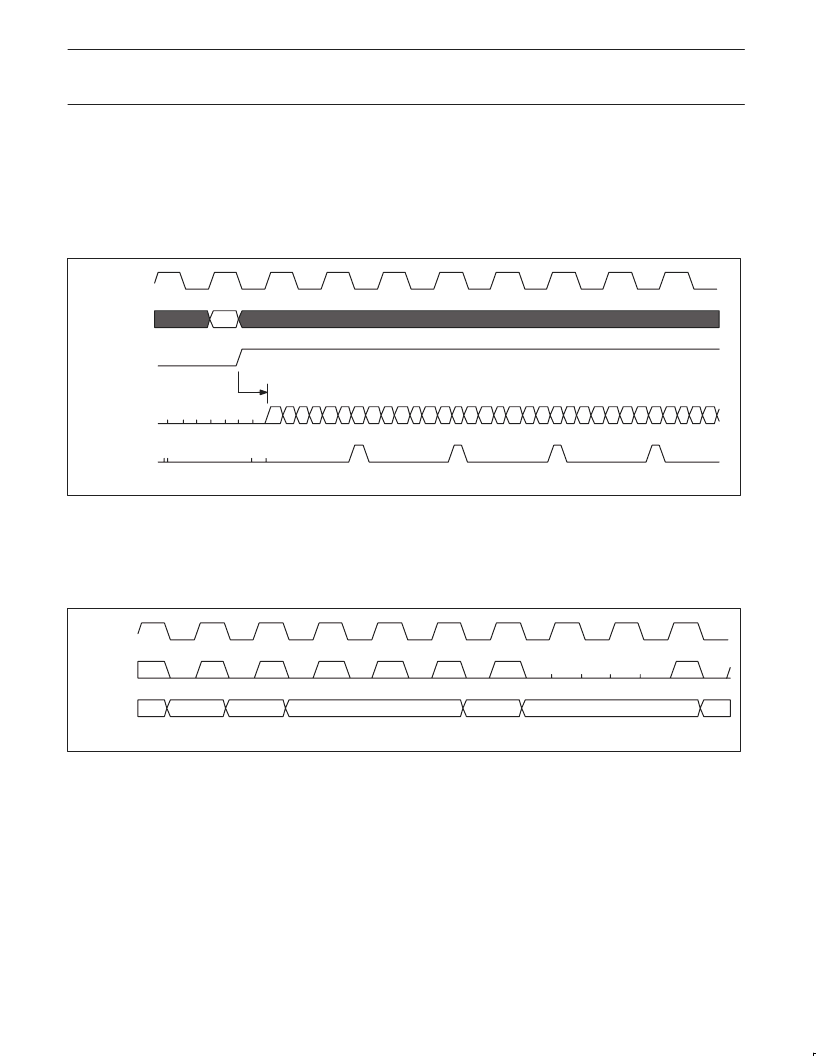- 您現在的位置:買賣IC網 > PDF目錄382720 > UCB1100 (NXP Semiconductors N.V.) Advanced modem/audio analog front-end PDF資料下載
參數資料
| 型號: | UCB1100 |
| 廠商: | NXP Semiconductors N.V. |
| 英文描述: | Advanced modem/audio analog front-end |
| 中文描述: | 先進的調制解調器/音頻模擬前端 |
| 文件頁數: | 24/36頁 |
| 文件大小: | 290K |
| 代理商: | UCB1100 |
第1頁第2頁第3頁第4頁第5頁第6頁第7頁第8頁第9頁第10頁第11頁第12頁第13頁第14頁第15頁第16頁第17頁第18頁第19頁第20頁第21頁第22頁第23頁當前第24頁第25頁第26頁第27頁第28頁第29頁第30頁第31頁第32頁第33頁第34頁第35頁第36頁

Philips Semiconductors
Preliminary specification
UCB1100
Advanced modem/audio analog front-end
1998 May 08
24
6.7.2
The audio and telecom codecs both operate at a programmable sample rate slower than the data transfer rate of the serial bus. The codecs
sample the contents of the appropriate field each time their internal counters indicate that a new sample is necessary. They update the data
read by the serial interface in the same manner. The counters for the audio and telecom subsystems are reset each time the respective
subsection is turned on (whenever the audio/telecom input or output path enable bits are set) and counting begins at the next SIBSync input
pulse (see Figure 26). The controlling devices must be both frequency and phase synchronized to the sample rate counters within the UCB1100
in order to ensure correct operation.
Codec Data Transfer
tcodstr
#1
0
1
2
3
4
5
6
0
1
2
3
4
5
6
0
1
2
3
4
5
6
0
1
2
3
4
5
6
0
1
2
3
sibclk/128
sibdin
codec enable
sample counter
sample pulse
SN00151
Figure 26.
Start of the codec sample counters (divisor set to 7). Sibdin sub frame #1 contains the codec input and/or output path
enable bit, the codec enable signal is the ‘OR’ function of the associated code input and output enable bit.
The codec data is loaded in the codec input register after the sub frame has been sent completely, when the appropriate data valid flag was set
in the sib frame. The codec input data is not refreshed, whenever the audio and/or telecom data valid flag equals ‘0’ in the sub frame or when no
sibdin data is transmitted.
#1
#1
#1
#2
#2
#1
#1
#3
#3
#1
N
N+1
N+2
N+3
N+4
N+5
sibclk/128
sibdin stream
codec input data
SN00152
Figure 27.
Codec input data handshake protocol, sibdin frame #1 contains codec data and the data valid flag equals ‘1’,
sib frame #2 contains codec data, but the data valid flag equals ‘0’, sib frame #3 contains no data.
Codec data must be received by the UCB1100 in one of the SIB frames preceding the sample moment of the codec, it uses the last sample
received before the sample moment. In case no refreshed codec data has been sent, the UCB1100 re-uses the available ‘old’ codec data
sample. This will lead to high distortion in the codec circuits.
相關PDF資料 |
PDF描述 |
|---|---|
| UCB1100LP | Advanced modem/audio analog front-end |
| UCB1200 | Advanced modem/audio analog front-end |
| UCB1200BE | Advanced modem/audio analog front-end |
| UCB1300 | Advanced modem/audio analog front-end |
| UCB1300BE | Advanced modem/audio analog front-end |
相關代理商/技術參數 |
參數描述 |
|---|---|
| UCB1100LP | 制造商:PHILIPS 制造商全稱:NXP Semiconductors 功能描述:Advanced modem/audio analog front-end |
| UCB1100LP/X3 | 制造商:PHILIPS 制造商全稱:NXP Semiconductors 功能描述:Advanced modem/audio analog front-end |
| UCB-12 | 功能描述:斷路器 CIRCUIT BREAKER RoHS:否 制造商:Phoenix Contact 產品:Device Circuit Breakers 產品類型:Thermomagnetic 電流額定值:2 A 電壓額定值 AC:240 V, 277 V 電壓額定值 DC:50 V 極數:1 Pole 執行器類型:Slide 電路功能:Trip Free 系列:CB TM1 工作溫度范圍:- 30 C to + 60 C 照明:No |
| UCB1200 | 制造商:PHILIPS 制造商全稱:NXP Semiconductors 功能描述:Advanced modem/audio analog front-end |
| UCB1200B | 制造商:未知廠家 制造商全稱:未知廠家 功能描述:UCB1200B |
發布緊急采購,3分鐘左右您將得到回復。